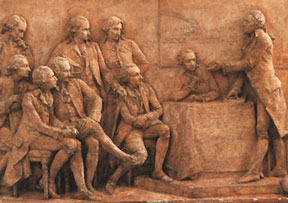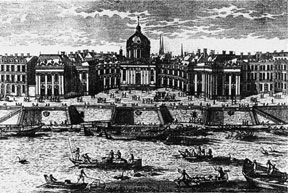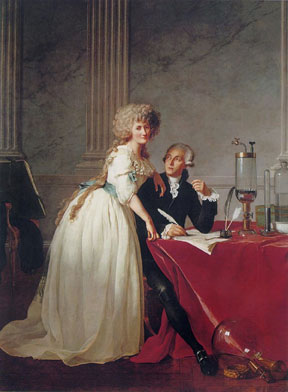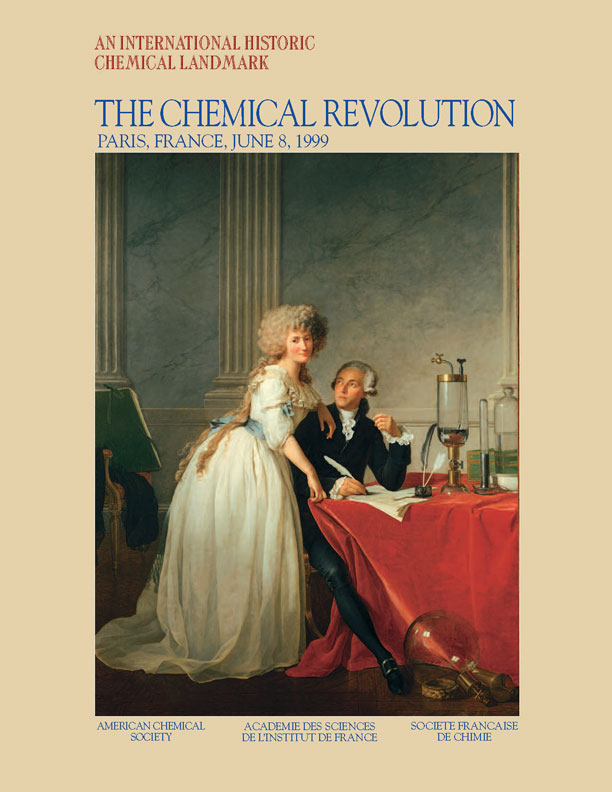The Chemical Revolution of Antoine-Laurent Lavoisier
Dedicated June 8, 1999, at the Académie des Sciences de l’Institut de France in Paris, France.
En español: La revolución química de Antoine-Laurent Lavoisier
Antoine-Laurent Lavoisier forever changed the practice and concepts of chemistry by forging a new series of laboratory analyses that would bring order to the chaotic centuries of Greek philosophy and medieval alchemy. Lavoisier’s work in framing the principles of modern chemistry led future generations to regard him as a founder of the science.
Contents
Beliefs in Chemistry at Lavoisier’s Time
When the 17-year-old Lavoisier left Mazarin College in Paris in 1761, chemistry hardly could be called a true science. Unlike physics, which had come of age through the work of Isaac Newton a century earlier, chemistry was still mired in the legacy of the Greek philosophers. The four elements of Aristotle — earth, air, fire, and water — had been slowly modified by the medieval alchemists, who added their own arcane language and symbolism.
Thrown into this mix was the concept of phlogiston. Developed by the German scientist Georg Ernst Stahl early in the 18th century, phlogiston was a dominant chemical concept of the time because it seemed to explain so much in a simple fashion. Stahl believed that every combustible substance contained a universal component of fire, which he named phlogiston, from the Greek word for inflammable. Because a combustible substance such as charcoal lost weight when it burned, Stahl reasoned that this change was due to the loss of its phlogiston component to the air.
It followed that the less residue a substance left after burning, the greater its phlogiston content. Turning from organic substances to metals, Stahl knew that a metal calx (known today as an oxide) heated with charcoal formed the original metal. He proposed that the phlogiston of the charcoal had united with the calx. Therefore, metals, which were thought to contain phlogiston, were also classified as combustibles.
The difficulty with this scheme was the reverse reaction. When metals were strongly heated in air, the resulting calx weighed more than the original metal, not less, as would be expected if the lead had lost the phlogiston component. This inconsistency caused some phlogistonists to suggest that phlogiston might even have a negative weight. Lavoisier was introduced to phlogiston by Guillaume Franåois Rouelle, whose lectures he attended while pursuing a law degree. By 1772, having abandoned law to pursue a career in science, Lavoisier turned his curiosity to the study of combustion.

The importance of the end in view prompted me to undertake all this work, which seemed to me destined to bring about a revolution in…chemistry. An immense series of experiments remains to be made."
— Antoine-Laurent Lavoisier, February 20, 1773
Combustion and the Attack on Phlogiston
In experiments with phosphorus and sulfur, both of which burned readily, Lavoisier showed that they gained weight by combining with air. With lead calx, he was able to capture a large amount of air that was liberated when the calx was heated. To a suspicious Lavoisier, these results were not explained by phlogiston.
Although Lavoisier now realized that combustion actually involved air, the exact composition of air at that time was not clearly understood. In August 1774, the eminent English natural philosopher Joseph Priestley met with Lavoisier in Paris. He described how he had recently heated mercury calx (a red powder) and collected a gas in which a candle burned vigorously. Priestley believed his "pure air" enhanced respiration and caused candles to burn longer because it was free of phlogiston. For this reason, he called the gas that he obtained from decomposing mercury calx “dephlogisticated air.”
In Paris, the intrigued Lavoisier repeated Priestley's experiment with mercury and other metal calces. He eventually concluded that common air was not a simple substance. Instead, he argued, there were two components: one that combined with the metal and supported respiration and the other an asphyxiant that did not support either combustion or respiration. By 1777, Lavoisier was ready to propose a new theory of combustion that excluded phlogiston. Combustion, he said, was the reaction of a metal or an organic substance with that part of common air he termed "eminently respirable." Two years later, he announced to the Royal Academy of Sciences in Paris that he found that most acids contained this breathable air. Lavoisier called it oxygène, from the two Greek words for acid generator.
Lavoisier began his full-scale attack on phlogiston in 1783, claiming that "Stahl's phlogiston is imaginary." Calling phlogiston "a veritable Proteus that changes its form every instant," Lavoisier asserted that it was time "to lead chemistry back to a stricter way of thinking" and "to distinguish what is fact and observation from what is system and hypothesis." As a starting point, he offered his theory of combustion, in which oxygen now played the central role.
Early Beliefs about Phlogiston
In the mid-18th century, the most pressing issue in chemistry and physics was to determine what exactly happens when something burns. The prevailing theory was that flammable materials contained a substance called “phlogiston” (from the Greek word for burn) that was released during combustion.
The theory held that when a candle burned, for example, phlogiston was transferred from it to the surrounding air. When the air became saturated with phlogiston and could contain no more, the flame went out. Breathing, too, was a way to remove phlogiston from a body. A typical test for the presence of phlogiston was to place a mouse in a container and measure how long it lived. When the air in the container could accept no more phlogiston, the mouse would die.
Antoine Lavoisier disproved the existence of phlogiston and helped to form the basis of modern chemistry using Joseph Priestley’s discovery of oxygen.
A New Chemistry Emerges
In 1766, Englishman Henry Cavendish isolated a gas that he called "inflammable air" because it burned readily. Priestley noted that when inflammable air and common air were ignited with a spark in a closed vessel, a small amount of "dew" formed on the glass walls. When Cavendish repeated the experiment, he found that the dew was actually water. Cavendish explained the results in terms of phlogiston and assumed the water was present in each of the two airs before ignition.
For Lavoisier, combustion meant combining with oxygen; however, until he could explain the combustion of inflammable air, some would still doubt his new chemistry. In June 1783, Lavoisier reacted oxygen with inflammable air, obtaining "water in a very pure state." He correctly concluded that water was not an element but a compound of oxygen and inflammable air, or hydrogen as it is now known. To support his claim, Lavoisier decomposed water into oxygen and inflammable air. Now that the composition of water was known, the last objection to discarding phlogiston could be eliminated.
To Lavoisier, it was time "to rid chemistry of every kind of impediment that delays its advance" with a reform that included a new language. Louis Bernard Guyton de Morveau, Claude Louis Berthollet, Antoine Franåois Fourcroy, and Lavoisier adopted the long-neglected idea of an element as originally proposed by Robert Boyle more than a century earlier. They retained the names from the past of many simple substances, or elements. But when an element combined with another element, the compound's name now reflected something about its chemical composition. For example, a calx was the combination of a metal and oxygen; therefore, zinc calx became zinc oxide. Lavoisier and his colleagues predicted that if the new system was "undertaken upon sound principles...it will naturally adapt itself to future discoveries." Withstanding the test of time, the basic system is still in use today.
Lavoisier's new system of chemistry was laid out for everyone to see in the Traité élémentaire de Chimie (Elements of Chemistry), published in Paris in 1789. As a textbook, the Traité incorporated the foundations of modern chemistry. It spelled out the influence of heat on chemical reactions, the nature of gases, the reactions of acids and bases to form salts, and the apparatus used to perform chemical experiments. For the first time, the Law of the Conservation of Mass was defined, with Lavoisier asserting that "... in every operation an equal quantity of matter exists both before and after the operation." Perhaps the most striking feature of the Traité was its "Table of Simple Substances," the first modern listing of the then-known elements.
Lavoisier did not expect his ideas to be adopted at once, because those who believed in phlogiston would "adopt new ideas only with difficulty." Lavoisier put his faith in the younger generation who would be more open to new concepts. Two years later, in 1791, the results were obvious. "All young chemists," he mused, "adopt the theory, and from that I conclude that the revolution in chemistry has come to pass." His legacy endures more than 200 years later.

The Life of Antoine-Laurent Lavoisier (1743-1794)
"Lavoisier was a Parisian through and through and a child of the enlightenment," wrote biographer Henry Guerlac. The son of Jean-Antoine and Émilie Punctis Lavoisier, he entered Mazarin College when he was 11. There, he received a sound training in the arts and classics and an exposure to science that was the best in Paris. Forgoing his baccalaureate of arts degree, Lavoisier yielded to the influence of his father and studied law, receiving a law degree in 1763. But his interest in science prevailed, kindled by the geologist Jean-Étienne Guettard, whom he met at Mazarin. After graduation, he began a long collaboration with Guettard on a geological survey of France.
Lavoisier showed an early inclination for quantitative measurements and soon began applying his interest in chemistry to the analysis of geological samples, especially gypsum. Because of his flair for careful analyses and his prodigious output, he was elected to the Academy of Sciences at the age of 25. At the same time, Lavoisier used part of the fortune he had inherited from his mother to buy a share in the Ferme Générale, a private group that collected various taxes for the government. This fateful decision would later cost him his life at the height of his intellectual powers.
He married Marie Anne Pierrette Paulze on Dec. 16, 1771; he was 28, she was 14. "The marriage was a happy one," according to Lavoisier biographer Douglas McKie. "Mme Lavoisier was possessed of a high intelligence; she took a great interest in her husband's scientific work and rapidly equipped herself to share in his labors. Later, she helped him in the laboratory and drew sketches of his experiments. She made many of the entries in his laboratory notebooks. She learned English and translated a number of scientific memoirs into French."
Lavoisier became further involved in public life in 1775, when he was appointed one of four commissioners of the Gunpowder Commission, charged with reforming and improving the production of gunpowder. Lavoisier moved his residence and laboratory to the arsenal in Paris, where for almost 20 years it drew many distinguished visitors. He devoted several hours every day and one full day a week to experiments in his laboratory. According to his wife: "It was for him a day of happiness; some friends who shared his views and some young men proud to be admitted to the honor of collaborating in his experiments assembled in the morning in the laboratory. There they lunched; there they debated... It was there that you could have heard this man with his precise mind, his clear intelligence, his high genius, the loftiness of his philosophical principles illuminating his conversation."
Ironically, Lavoisier, the ardent and zealous chemical revolutionary, was caught in the web of intrigue of a political revolution. The TraitÉ was published in 1789, the same year as the storming of the Bastille. A year later, Lavoisier complained that "the state of public affairs in France...has temporarily retarded the progress of science and distracted scientists from the work that is most precious to them."
Lavoisier, however, could not escape the wrath of Jean-Paul Marat, the adamant revolutionary who began publicly denouncing him in January 1791. During the Reign of Terror, arrest orders were issued for all of the Ferme Générale, including Lavoisier. On the morning of May 8, 1794, he was tried and convicted by the Revolutionary Tribunal as a principal in the "conspiracy against the people of France." He was sent to the guillotine that afternoon. The next day, his friend, the French mathematician Joseph-Louis Lagrange, remarked that "it took them only an instant to cut off that head, and a hundred years may not produce another like it."
Further Reading
- Société Française de Chimie (Chemical Society of France)
- Antione-Laurent Lavoisier (Chemical Heritage Foundation)
- En español: La revolución química de Antoine-Laurent Lavoisier
Landmark Designation and Acknowledgments
Landmark Designation
The American Chemical Society and the Société Française de Chimie designated Antoine-Laurent Lavoisier: The Chemical Revolution as an International Historic Chemical Landmark at the Royal Academy of Sciences in Paris on June 8, 1999. The English version of the text of the plaque presented to the Académie des Sciences de l'Institut de France reads:
In these buildings, then "Collège Mazarin" or "des Quatre-Nations," Antoine-Laurent Lavoisier (1743-1794) studied from 1754 to 1761. He was elected to the Royal Academy of Sciences in 1768, where he presented his important studies on oxygen in chemistry. These began with a "pli cacheté" of Nov. 2, 1772, and, after he experimentally proved the chemical composition of water by the quantitative method, culminated in his abandoning of the phlogistic theory in 1785. In 1787, he proposed the principles of a new Méthode de Nomenclature Chimique, in collaboration with the chemists Guyton de Morveau, Berthollet, and Fourcroy and with the help of the mathematicians Monge and Laplace. The publication of his Traité Elémentaire de Chimie two years later convinced French and foreign chemists of his theories. His papers, stored in the Archives of the Academy of Sciences, bear witness to the conception and maturing of his revolutionary ideas, which are at the foundations of modern chemistry.
Acknowledgments
Adapted for the internet from “The Chemical Revolution," produced by the National Historic Chemical Landmarks program of the American Chemical Society in 1999.
Back to National Historic Chemical Landmarks Main Page.
Learn more: About the Landmarks Program.
Take action: Nominate a Landmark and Contact the NHCL Coordinator.
En español: La revolución química de Antoine-Laurent Lavoisier



